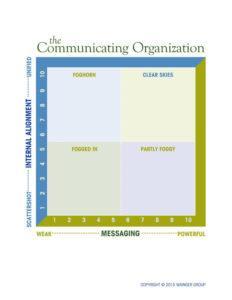 If asked, most executives will say that clear, compelling and effective communications is essential to the success of their enterprise. The reality is that this is an area where so many organizations fall short. It’s not because they don’t try and not because they don’t have the right words or the right approach; rather, they haven’t figured out how to make it happen.
If asked, most executives will say that clear, compelling and effective communications is essential to the success of their enterprise. The reality is that this is an area where so many organizations fall short. It’s not because they don’t try and not because they don’t have the right words or the right approach; rather, they haven’t figured out how to make it happen.
The art and science of transforming communications strategy into action can’t be delegated solely to a communications department. Connecting, engaging, informing, and sharing information with your internal and external stakeholders must be part of an organization’s DNA.
In our work with corporate and nonprofit clients, we find the communications highway is paved with good intentions. Many organizations invest heavily in message development, communications planning, and tactical resources. But they aren’t as effective they could be because the communications efforts and objectives are not socialized and aligned throughout the enterprise. The result is that staff members, boards of directors or advisors, partners, and other associates don’t know what messages to use or are incapable of articulating them. Even worse, they might not believe in the messages. As a result, all that investment of time and money is not fully realized.
Over the years, we have developed a diagnostic to identify where an organization is on the spectrum of messaging and the internal integration/alignment of that messaging. Where would you place your enterprise?
Clear Skies These are companies and organizations that have a strong and powerful message with internal teams and key close-in stakeholders who embrace the messages and can carry them forth consistently. One of the best examples I’ve ever seen was in the nonprofit world—a charter management organization where everyone from teachers and principals to kindergarteners, parents, food service personnel and janitorial staff could tell you enthusiastically what the organization was all about. The message was simple: our students will go to college. Everyone understood both the message and their role in delivering on it.
Partly Foggy These are organizations that have a strong message but it’s not socialized well. An example of this is a company that reframed and repositioned its messages from discussions about the breadth and depth of service to focus on the value it brings to its customers. So far, so good. The problem is the firm didn’t involve its staff in the realignment process. So the company presented the team with new logos, taglines, and talking points that the staff didn’t fully embrace, nor were they convinced that the company could actually live up to its ambitiously stated new message.
Foghorns These firms and organizations have strong collaborative cultures: people work together, talk often. Their challenge is that they don’t always articulate what they do and why it matters in a compelling way. We worked with a technology company where people were passionate about their company and what they do. They wanted to tell everyone about it, but were unable to translate their passion and excitement in a way that others could understand. A lot of noise, but little understanding.
Fogged In These are companies and organizations that frankly need a lot of help. Like the foghorns, they don’t articulate a strong message. Neither are they on the same page in terms of the organization’s mission, vision and value. I’ve seen executives spend piles of money on external branding and communications consultants. But until they dig into deeper organizational issues and reveal a clarity about who they are, why they matter and how they will deliver on their promises, no amount of tweets, media outreach, blog posts and advertising will get them where they want to go.
In a time where the world has gone social and connections and possibilities are growing every day, companies and organizations must dispel the fog and move toward clear skies. It isn’t enough to have a communications department—you have to become a communicating organization.

